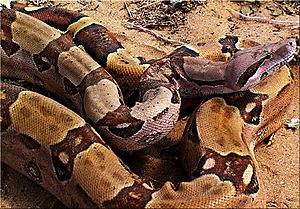Boa facts for kids
Quick facts for kids Boidae |
|
|---|---|
 |
|
| Boa constrictor | |
| Scientific classification | |
| Kingdom: | |
| Subphylum: | |
| Class: | |
| Order: | |
| Suborder: | |
| Family: |
Boidae
Gray, 1825
|
Boidae, often called boas, are a group of snakes. They are a family of non-venomous snakes. This means they do not have venom to hunt or defend themselves. Famous boas include the boa constrictor and the anaconda.
Most boas live in North and South America. But you can also find some in Africa, Europe, and Asia. Some boas even live on islands in the Pacific Ocean. Adult boas are usually medium to large in size. Female boas are often bigger than males. There are many different kinds of boas. Scientists have found 43 different species of boas.
Contents
All About Boas
Boas are amazing snakes known for their strength. They are constrictors, which means they squeeze their prey. They wrap their bodies around an animal and squeeze it tightly. This stops the animal from breathing. Boas eat small mammals, birds, and sometimes other reptiles.
Where Do Boas Live?
Boas live in many different places around the world. Most of them prefer warm, tropical areas. They can be found in rainforests, deserts, and even grasslands. Some boas live in trees, while others live on the ground. A few types of boas even spend time in water.
Boas in the Americas
The Americas are home to many boa species. The boa constrictor is very common there. Anacondas, which are the heaviest snakes in the world, also live in South America. They often live near water, like rivers and swamps.
Boas in Other Parts of the World
While most boas are in the Americas, some live elsewhere. For example, the sand boas are found in parts of Africa, Europe, and Asia. These snakes are usually smaller. They often burrow under the sand or soil.
What Makes Boas Special?
Boas have several unique features. They are known for their powerful bodies. Their scales can be very colorful and patterned. This helps them blend into their surroundings. Boas also have special heat-sensing pits on their faces. These pits help them find warm-blooded prey, even in the dark.
How Boas Hunt
Boas are ambush predators. This means they wait quietly for their prey to come by. Once an animal is close enough, the boa strikes quickly. It grabs the animal and wraps its body around it. The boa then squeezes until the animal stops moving. After that, the boa swallows its meal whole.
Boa Babies
Most snakes lay eggs, but many boas give birth to live young. This is called being "viviparous." The babies develop inside the mother's body. When they are born, they are already small versions of the adults. They can hunt and take care of themselves right away.
Images for kids
See also
 In Spanish: Boa para niños
In Spanish: Boa para niños


